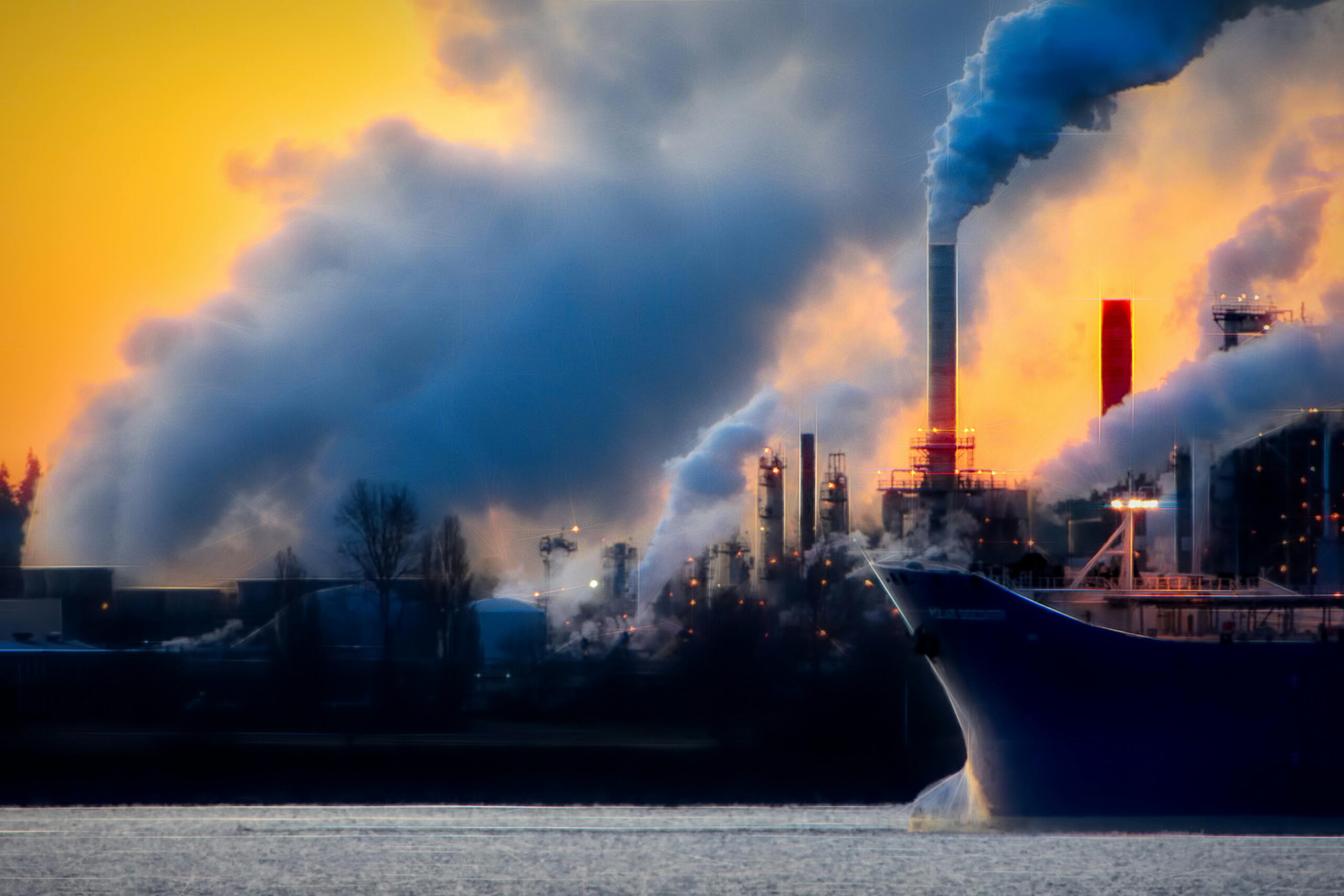
When we burn fossil fuels for energy, we release CO2, a major greenhouse gas, into the atmosphere. This traps heat, causing our planet to warm. Carbon capture technology steps in at this point, acting like a filter, capturing the CO2 before it escapes into the air.
What is carbon capture technology?
Carbon capture technology, also known as carbon capture and storage (CCS), is a group of techniques aimed at capturing carbon dioxide (CO2) emissions from various sources before they enter the atmosphere and storing them safely for the long term.
There are three main types of carbon capture technology, each with its own approach to capturing CO2 emissions:
1. Post-Combustion Capture:
This method is commonly used in power plants and industrial facilities and captures CO2 from the flue gas, which is the exhaust gas emitted after the combustion process. Here’s how it works:
- Flue gas is treated with chemical solvents or adsorbent materials.
- These materials selectively bind to CO2 molecules, separating them from the other gases in the mixture.
- The captured CO2 is then desorbed (released) from the capture material, while the regenerated material is reused for further capture cycles.
2. Pre-Combustion Capture:
This method is primarily used in industrial processes like hydrogen production or syngas production. Here’s the process:
- Fossil fuels are converted into a mixture of gases (syngas) before combustion.
- The syngas is treated with physical or chemical separation methods to remove CO2 before it enters the combustion stage.
- The purified syngas is then used for various applications, while the captured CO2 can be stored safely.
3. Direct Air Capture (DAC):
This innovative technology is designed to capture CO2 directly from the atmosphere, not just from specific emission sources. Here’s a simplified explanation:
- Large air filters are used to draw in ambient air.
- These filters contain specialized materials that selectively capture CO2 molecules.
- The captured CO2 is then concentrated and separated from the remaining air.
- The extracted CO2 can then be stored or potentially utilized in various applications.
Does carbon capture actually work?
Carbon capture technology does work, but it’s a complex issue with both promises and limitations:
The good news:
- Proven technology: Carbon capture has been used successfully for decades in specific applications, like capturing CO2 from natural gas production for enhanced oil recovery.
- Reduces emissions: When implemented effectively, it can significantly reduce CO2 emissions from certain sources like power plants and factories.
- Potential for negative emissions: Direct air capture (DAC) technology has the potential to remove existing CO2 from the atmosphere, not just prevent new emissions. This could be crucial in mitigating the effects of climate change.
There are also challenges and concerns:
- Cost: Currently, carbon capture is expensive to implement and operate, making it a less attractive option for widespread use without significant cost reductions.
- Storage: Safely storing captured CO2 over long periods requires careful geological assessments and monitoring to ensure no leakage.
- Limited application: While promising, carbon capture isn’t a “silver bullet” solution. It’s most effective for specific industries and may not be suitable for all sources of CO2 emissions.
- Potential for “greenwashing”: Some argue that relying on carbon capture technology could create a false sense of security and delay crucial efforts to reduce emissions at the source.
Materials Used in Carbon Capture Technology:
Carbon capture technology relies on various materials to perform its functions effectively. These materials play crucial roles in capturing, separating, transporting, and storing CO2. Here are some key examples:
1. Capture Materials:
- Solvents: These are chemical solutions used in chemical capture processes. They have an affinity for CO2, allowing them to “grab” it from other gases in the emission stream. Examples include amines, which are organic compounds containing nitrogen.
- Adsorbents: These are solid materials with a porous structure that attracts and holds CO2 molecules on their surface. Examples include activated carbon, zeolites (crystalline materials), and metal-organic frameworks (MOFs).
2. Separation Materials:
- Membranes: These are thin, selective barriers that allow CO2 to pass through while blocking other gases. They play a crucial role in separating CO2 from the mixture of gases after capture. Different types of polymers and ceramic materials are used to create membranes with the desired properties.
3. Transport Materials:
- Pipelines: These are used to transport captured CO2 in its compressed form from capture sites to storage locations. Carbon steel is a commonly used material for pipelines due to its strength and cost-effectiveness, but research is ongoing to explore materials with improved resistance to CO2 corrosion.
- Ships: For long-distance transportation of large volumes of CO2, specially designed ships are used. These ships often utilize refrigerated tanks to keep the CO2 in its liquid form, increasing storage density.
4. Storage Materials:
- Geological formations: Deep saline aquifers and depleted oil and gas reservoirs are the primary geological formations used for CO2 storage. These formations offer large storage capacity and natural geological barriers to prevent CO2 leakage. The rock and mineral composition of these formations play a vital role in ensuring safe and long-term storage.
Material Development:
- Research and development efforts are constantly seeking to identify and develop new materials with improved properties for carbon capture technology. This includes materials that are:
- More efficient in capturing CO2
- More selective for CO2, capturing it with minimal capture of other gases
- More cost-effective to produce and utilize
- More durable and resistant to degradation for long-term applications
Comparison of Carbon Capture Technologies:
| Category | Description | Pros | Cons |
|---|---|---|---|
| Post-Combustion Capture | Captures CO2 from flue gas after combustion | – Mature technology with proven applications | – High energy consumption |
| Pre-Combustion Capture | Removes CO2 from syngas before combustion | – Can be integrated with existing industrial processes | – Complex technology with high upfront costs |
| Direct Air Capture (DAC) | Captures CO2 directly from the atmosphere | – Can remove existing CO2, not just prevent new emissions | – Still in early stages of development |
Public Perception and Environmental Impact of Carbon Capture Technology:
Public Perception:
- Limited Awareness: Despite growing interest surrounding climate change, public awareness of carbon capture technology (CCT) remains relatively low. This can hinder public support and acceptance, which can be crucial for the technology’s large-scale deployment.
- Mixed Views: Existing studies reveal mixed public opinions on CCT. Some people see it as a promising tool for fighting climate change, while others express concerns about its safety, cost, and potential for delaying emission reduction efforts.
- Concerns and Questions: Public concerns surrounding CCT often focus on:
- Safety: Fears of potential leakage of stored CO2 and its environmental and health impacts.
- Cost-effectiveness: Concerns about the high costs of implementing and maintaining CCT, potentially impacting energy prices.
- Safety: Fears of potential leakage of stored CO2 and its environmental and health impacts.
- Efficacy: Doubts about the long-term effectiveness of CCT and its potential for delaying the transition to renewable energy sources.
- Importance of Communication: Addressing these concerns through transparent communication, public engagement, and education is crucial for building trust and gaining public acceptance for CCT.
Environmental Impact:
- Potential Benefits:
- Reduced CO2 Emissions: CCT has the potential to significantly reduce CO2 emissions from various sources, including power plants and industrial facilities.
- Mitigation of Climate Change: By reducing the amount of CO2 entering the atmosphere, CCT can help mitigate the effects of climate change.
- Negative Emissions Technology: Direct Air Capture (DAC) technology even has the potential to remove existing CO2 from the atmosphere, potentially accelerating climate change mitigation efforts.
- Reduced CO2 Emissions: CCT has the potential to significantly reduce CO2 emissions from various sources, including power plants and industrial facilities.
- Potential Risks:
- Geological Storage Risks: Leakage of stored CO2 from geological formations could have negative environmental and health impacts, potentially negating the environmental benefits of CCT.
- Energy Consumption: Some CCT methods require significant energy input, which can contribute to greenhouse gas emissions if not powered by renewable energy sources.
- Unforeseen Consequences: The long-term environmental impacts of large-scale CCT deployment, especially DAC, are still being researched and unforeseen consequences cannot be entirely ruled out.
- Geological Storage Risks: Leakage of stored CO2 from geological formations could have negative environmental and health impacts, potentially negating the environmental benefits of CCT.
New Discovery:
As of February 29, 2024, a significant breakthrough in carbon capture technology was reported in September 2022 by a team at the University of Illinois Chicago (UIC). Here’s an exciting development in this field:
100% Conversion to Ethylene:
This new method involves capturing CO2 from industrial exhaust and converting it entirely, 100%, into ethylene, a building block for various plastic products. This is a significant advancement compared to existing methods that achieve much lower conversion rates and often require additional separation processes.
Electrochemical Process:
This technology utilizes electrolysis, a process that uses electricity to drive chemical reactions. Captured CO2 is passed through a special cell, along with water, where an electric current transforms the CO2 into ethylene, with oxygen and other carbon-based fuels as byproducts.
Potential for Carbon Negativity:
Unlike other capture methods that simply store CO2 underground, this approach recycles the captured carbon into a usable product. Additionally, if the electricity used in the process comes from renewable sources, the entire system can be considered carbon negative, meaning it removes more CO2 from the environment than it emits.
This new discovery demonstrates the ongoing advancements in carbon capture technology, offering exciting possibilities for not only reducing emissions but also utilizing captured CO2 in a sustainable manner.
Conclusion:
Carbon capture technology offers a potentially powerful tool in the fight against climate change. However, it’s not a silver bullet solution. While it can significantly reduce emissions and even remove existing CO2, concerns about safety, cost, and potential drawbacks necessitate further research and responsible implementation. Building public trust and ensuring environmental sustainability are crucial for this technology to play a meaningful role in creating a cleaner future.
References:
Here are some authentic sources where you can learn more about carbon capture technology:
- Carbon Capture and Storage (CCS) Overview by the International Energy Agency (IEA):
- Carbon Capture and Storage Association (CCSA):
- United States Department of Energy (DOE) – Carbon Capture Program:
- Carbon Capture and Storage Research at MIT:
- Carbon Capture and Utilization (CCU) Research at Columbia University:
Frequently Asked Questions about Carbon Capture Technology:
1. What technology is used in carbon capture?
Carbon capture technology utilizes various approaches depending on the specific method and source of emissions. Here are some key technologies:
Chemical Capture: This method employs solvents or adsorbents, special materials with an affinity for CO2, to “grab” it from other gases in the emission stream. These materials bind to CO2 molecules, separating them from the mix.
Physical Capture: This technique uses physical processes like cooling and pressure changes to separate CO2 from the mixture of gases. It’s similar to sifting flour from a bowl of mixed ingredients, but on a larger scale.
Membranes: Think of these as thin, selective barriers that allow CO2 to pass through while blocking other gases. They are used in separation processes after the initial capture to further purify the CO2.
2. What is CCUS technology?
CCUS stands for Carbon Capture, Utilization, and Storage. It’s the entire process of capturing CO2 emissions, using them for various applications, and finally storing them safely for the long term.
Here’s a breakdown of the three stages:
Capture: As described above, this involves separating CO2 from emission sources, like power plants or factories.
Utilization: Instead of just storing the captured CO2, it can be converted into useful products like fuels, chemicals, or even building materials.
Storage: The remaining or unused CO2 is injected deep underground into geological formations like depleted oil and gas reservoirs or saline aquifers for safe and long-term storage.
3. What is the current state of carbon capture technology?
Carbon capture technology is evolving, with some aspects further along than others:
Post-combustion capture is the most mature technology, having been successfully used in specific applications for decades.
Pre-combustion capture and direct air capture (DAC) are in earlier stages of development but hold promise for capturing CO2 from diverse sources.
Cost reductions, efficiency improvements, and innovation in materials and processes are crucial for widespread adoption of carbon capture technology.
4. What is the most promising carbon capture technology?
Unfortunately, there’s no single “most promising” technology. Each method has its own pros and cons, making it suitable for different situations. Here’s a brief overview:
Post-combustion capture: While mature and proven, it has limitations in energy efficiency and can be expensive.
Pre-combustion capture: This technology can potentially integrate well with existing industrial processes but requires additional steps and has high upfront costs.
Direct air capture (DAC): This method holds the potential for removing existing CO2 and even achieving negative emissions, but it’s still in early development and faces challenges like high energy consumption and cost.







